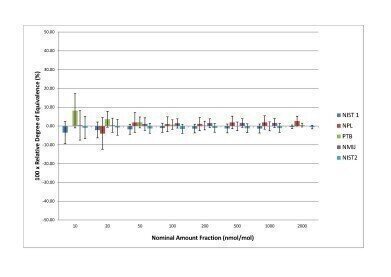Measurement and Testing
Standards Compared in Moisture Measurement at Leading Institutes
Oct 17 2011
When four of the world’s leading national metrology labs took the bold step of comparing their primary moisture standards, the tool of choice --a Tiger Optics LaserTrace --performed admirably. Measurements deviated less than 2 percent over the course of the three-year, multinational inter-comparison, thereby permitting the facilities to establish a much-needed baseline for future work. The groundbreaking study --undertaken by the European Association of National Metrology Institutes (EURAMET) --relied solely upon the company’s LaserTrace, along with a back-up compact HALO instrument, also from Tiger Optics (USA).
The performance of the Tiger Optics instruments permitted scientists to compare standard generation facilities by shipping the analytical instruments --in lieu of cumbersome standards --to the participants in the United Kingdom (National Physical Laboratory), the United States (National Institute of Standards and Technology), Japan (National Metrology Institute of Japan), and Germany (Physikalisch-Technische Bundesanstalt).
The measurement of trace amounts of moisture contamination is of utmost importance to a number of manufacturers and suppliers of purge and process gases. The semiconductor industry, for example, regards moisture as one of the most difficult impurities to measure and to control. As manufacturers develop moisture analysers to detect ever-smaller amounts of contaminants, there is an equally pressing need for traceable calibration. Hence, EURAMET’s desire to compare facilities and quantify the variability among the standards and their accuracy at fraction amounts.
Until this study, an inter-comparison of such facilities was untenable, due to the characteristics of trace water-vapour standards. Such standards are produced via a dynamic method, for example; gravimetrically, or a frost-point generation, involving large, weighty, and complex pieces of equipment that are not readily brought together for comparison purposes. To resolve that problem, EURAMET elected to transport instruments, rather than standards.
The study was designed to compare the performance of each of the national metrology institute’s facilities over the range of 10 ppb to 2000 ppb. For the first time, participating laboratories were able to quantify the comparability of their trace water-vapour standard generation facilities, which proved to be excellent across the full range of measured amount fractions, as the graph illustrates.
“While we learned that such studies take considerably longer than anticipated, the chance to support the noble aim of achieving a comparable moisture standard worldwide was well worth it,” said Lisa Bergson, Tiger Optics’ founder and chief executive, adding, “Beyond that, we are proud of our analysers’ precision and robust performance. It’s great to be in a position to offer them to our friends in the institute community.”
Digital Edition
PIN 25.1 Feb/March
March 2024
In This Edition Safety - The technology behind the ION Science Tiger XT - Safety with ammonia and LOHCs as hydrogen carriers Analytical Instrumentation - Discussion on new tribology te...
View all digital editions
Events
Apr 30 2024 Birmingham, UK
May 03 2024 Seoul, South Korea
May 05 2024 Seville, Spain
May 06 2024 Riyadh, Saudi Arabia
May 06 2024 Houston, Tx, USA


















